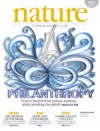 Early in his career, Paul Olsen sat in front of a television, expecting to see his own image. He had hosted a television crew on a research expedition to Manicouagan Crater in Canada, where he and his team were investigating the Triassic–Jurassic boundary in the geological record. Olsen, a palaeontologist at Lamont–Doherty Earth Observatory of Columbia University in Palisades, New York, had spent hours explaining and re-explaining for the camera how scientists used the site to reconstruct ancient ecologies. As the opening credits rolled, Olsen wondered how he would come across on the small screen.
Early in his career, Paul Olsen sat in front of a television, expecting to see his own image. He had hosted a television crew on a research expedition to Manicouagan Crater in Canada, where he and his team were investigating the Triassic–Jurassic boundary in the geological record. Olsen, a palaeontologist at Lamont–Doherty Earth Observatory of Columbia University in Palisades, New York, had spent hours explaining and re-explaining for the camera how scientists used the site to reconstruct ancient ecologies. As the opening credits rolled, Olsen wondered how he would come across on the small screen.
All posts by LL
Spanish researchers petition for taxpayer donations
Spanish scientists have collected more than 32,000 signatures in less than a week in support of a petition that urges Spain’s tax authority to adopt a novel way of raising funds for research: adding a checkbox to income tax forms that would allow taxpayers to direct 0.7% of their contribution to science. Continue reading Spanish researchers petition for taxpayer donations
Monsanto to face biopiracy charges in India
 An Indian government agency has agreed to sue the developers of genetically modified (GM) eggplant for violating India’s Biological Diversity Act of 2002. India’s National Biodiversity Authority (NBA) is alleging that the developers of India’s first GM food crop—Jalna-based Maharashtra Hybrid Seeds Company (Mahyco) partnered with St. Louis–based seed giant Monsanto and several local universities—used local varieties to develop the transgenic crop, but failed to gain the appropriate licenses for field trials. Continue reading Monsanto to face biopiracy charges in India
An Indian government agency has agreed to sue the developers of genetically modified (GM) eggplant for violating India’s Biological Diversity Act of 2002. India’s National Biodiversity Authority (NBA) is alleging that the developers of India’s first GM food crop—Jalna-based Maharashtra Hybrid Seeds Company (Mahyco) partnered with St. Louis–based seed giant Monsanto and several local universities—used local varieties to develop the transgenic crop, but failed to gain the appropriate licenses for field trials. Continue reading Monsanto to face biopiracy charges in India
Synthetic Stones Capture Carbon
While scrubbers in smokestacks at coal plants can pull out toxic gases like sulfur dioxide, scientists haven’t yet developed a cost-effective technology to remove carbon dioxide from industrial exhaust. Now European researchers have tinkered with the chemical composition of limestone to produce a material that absorbs almost twice as much CO2 as the natural mineral can (Environ. Sci. Technol., DOI: 10.1021/es2034697).